ICSE Solutions for Class 9 Geography – Humidity
ICSE SolutionsSelina ICSE SolutionsML Aggarwal Solutions
Exercises
I. Short Answer Questions.
Question 1.
Define the following terms :
(a) Precipitation
(b) Evaporation
(c) Condensation
(d) Humidity
(e) Latent heat.
Answer:
(a) Precipitation — It is process by which condensation in different forms falling on the ground e.g. rainfall, snowfall, drizzle, sleet and hail etc.
(b) Evaporation — It is the process of converting water into water droplets and vapour.
(c) Condensation — It is the process of converting the water- droplets into water.
(d) Humidity — It is the amount of moisture present in the atmospheric air.
(e) Latent heat — It is the unseen heat absorbed by the atmospheric air to form vapour after reaching boiling point of 100°C of water.
Question 2.
What determines the amount of water vapour in the air?
Answer:
The amount of water vapour or humidity is dependent on the temperature conditions, because the capacity of air to hold moisture changes according to the temperature, e.g., in higher temperature the water vapour amount may increase and in low temperature it may decrease.
Question 3.
How is relative humidity determined ?
Answer:
Relative humidity is the percentage of water vapour with respect to the amount of air at a particular temperature.

Question 4.
Name four chief forms of condensation.
Answer:
Four chief forms of condensation are clouds, fog, mist and dew droplets.
Question 5.
Mention the different forms of precipitation.
Answer:
Different forms of precipitation are rainfall, drizzling, hailstones, snowfall and sleet etc.
Question 6.
What do you understand by ‘condensation nuclei’ ?
Answer:
Condensation nuclei — Condensation nuclei is the base around which moisture is gathered and converts into a drop of water, e.g. the dust particles present in the atmosphere make the base of condensation form.
Question 7.
State the three types of rainfall.
Answer:
- Relief Rainfall – It occurs from the cooling of warm moist air which ascends above the mountain barrier lying in the direction of the prevailing winds.
- Cyclonic or Frontal Rainfall – It occurs when warm and cold air masses confront each other, the warmer air generally climbs above the colder air.
- Convectional Rainfall – Ascending currents of hot and humid air causes condensation of the clouds, resulting in heavy rainfall.
Question 8.
What is cyclonic rainfall ?
Answer:
Cyclonic rainfall is provided by the cyclones created in tropical and temperate regions along the air mass fronts, where warm and cold air meet together and the warm air is encircled by the cold air resulting in circular wind systems. The tropical cyclones provide heavy rainfall for a few days, but temperate cyclones provide light rainfall or drizzling for a long period.
Question 9.
How does latitude affect evaporation ?
Answer:
Evaporation is highest in the tropical belt due to continuous vertical rays of the sun, while in temperate belt less evaporation and in polar belt least evaporation takes place due to less insolation.
Question 10.
Why is evaporation maximum in tropical deserts surrounded by seas ?
Answer:
In tropical deserts, surrounded by seas, evaporation is maximum because of high temperatures and clear skies.
Question 11.
State the factors favouring evaporation.
Answer:
The conditions favourable for evaporation are high temperature and large amount of water of ocean, rainfall water etc.
Question 12.
What is the instrument used for measuring humidity?
Answer:
Hygrometer or Dry and Wet Bulb Thermometer is used to measure humidity.
Question 13.
State the process of clouds formation. Name the types of clouds.
Answer:
When the water vapour converts into the water droplets floating in the air, the clouds are formed. Main types of clouds are Cirrus, Cumulus, Altus and Stratus.
Question 14.
Name the regions which receive rainfall only in summer.
Answer:
The continental interiors in the sub-tropical regions get rainfall only in summer, e.g. Mangolia, Tibet etc.
Question 15.
Name two regions of heavy rainfall.
Answer:
Equatorial region and monsoon tropical region get highest rainfall. Highest rainfall is recorded in Cherrapunji and Mawsynram (1080 cm) in the world.
Question 16.
Describe the three chief ways in which condensation occurs.
Answer:
Three chief ways to assist condensation are :
- High amount of moisture present in atmosphere.
- The elements providing the nuclei for it should be present in atmosphere, e.g., dust particles, salt and smoke etc.
- The air should be saturated i.e. the relative humidity must be 100% to create dew point or the temperature should be below dew point.
II. Give reasons for each of the following
Question 1.
In Equatorial regions the sky often remains overcast with clouds.
Answer:
Due to excessive heat the evaporation takes place in fast speed, and in every afternoon rainfall occurs after heavy cloud formation by convection process. So the sky mostly remains overcast with clouds.
Question 2.
Human comfort depends on humidity.
Answer:
Human efficiency is best at 40% relative humidity. More or less humidity creates uneasiness of humidity and dryness.
Question 3.
Condensation is the reverse process of evaporation.
Answer:
Condensation takes place upto the dew-point comes, but after it precipitation starts due to water-droplets converted into water drops. So, condensation and precipitation are different processes occurring in different conditions and temperature episodes.
Question 4.
Coasts receive more rainfall than the interior of the continents.
Answer:
Moisture-laiden winds provide more rainfall to the coastal parts due to being situated by the coast and receiving the rain bearing winds, but the interior get negligible rainfall due to being the almost dry winds without moisture.
Question 5.
The windward sides of mountains receive more rainfall than the leeward sides.
Answer:
The windward sides of mountainous slopes get ample rainfall by striking with the rain bearing winds first, while the leeward sides cannot get sufficient rainfall due to being on other side where the winds become almost dry due to imparting rainfall in windward due to loss of major part of moisture and water drops.
III. Match the following
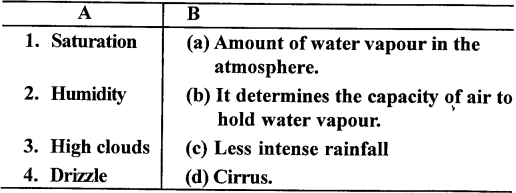
Answer:
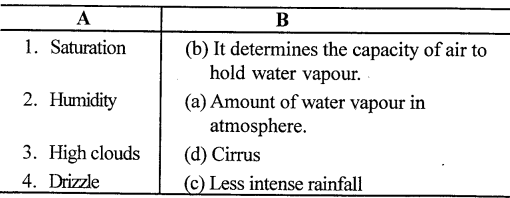
IV. Long Answer Questions.
Question 1.
Distinguish between Absolute Humidity and Relative Humidity.
Answer:
Absolute Humidity :
- It is the measure of the actual amount of water vapour in the air, regardless of temperature.
- It is expressed as grams of moisture per cubic meter of air(g/m3).
- The higher the amount of water vapour, the higher is the absolute humidity.
- In weather calculations, absolute humidity is generally not taken into account.
Relative Humidity:
- It measures water vapour in air but relative to the maximum vapour that the air can hold at that temperature.
- It is expressed as the ratio (percentage value) between the absolute humidity of a given mass of air and the maximum amount of water vapour that it can hold at the same temperature.
- Warm air possesses more water vapour than cold air, so with the same amount of absolute humidity, air will have a different relative humidity depending on temperature.
- It is the essential characteristic of weather forecasts, which indicates the likelihood of precipitation, dew or fog.
Question 2.
With reference to condensation, define the following :
(a) Process of condensation.
(b) Atmospheric conditions that favour condensation.
(c) Forms of Condensation.
Answer:
(a) Condensation is the reverse process of evaporation. In condensation, water vapour in the atmosphere get converted into water droplets or ice. Condensation takes place when water vapour is added to saturated air or when the temperature falls below the temperature at which air become saturated.
(b) The atmospheric conditions that favour condensation are :
- There should be a high amount of water vapour present in atmosphere.
- Minuscule particles of dust, salt and even smoke act as condensation nuclei.
- The temperature of air must be below dew point temperature so as to encourage condensation.
(c) Forms of condensation : Following are the forms of the
- condensation : Dew, frost, fog, mist, white frost and clouds. The clouds are formed when the temperature falls down below dew points, while dew, fog and clouds are formed when the temperature remains higher than the freezing point.
- Clouds : Clouds are formed when minute droplets of water vapour condense on a nuclei and remain suspended in air.
- Dew : When water vapour condenses on the surface, it forms tiny droplets of water called dew. Dew commonly occurs during winter on account of cooling of air below dew point.
- Frost : In very low temperature, when condensation occurs at zero metre or ground level, water vapour freezes into minute crystals of rice on objects near the ground such as blades of grass, leaves and tiny rock particles. Frost is harmful to plants.
- Fog and Mist : Fog and Mist are two related terms. Droplets of water suspended in the atmosphere close to the surface of the earth are termed as fog. On long winter nights, the ground cools more rapidly than the air above. Such cooling reduces temperature at the surface to below dew point. Water vapour at lower levels get condensed around minute solid particles to form fog.
PQ. Describe the process of evaporation together with factors that favour it.
Answer:
For evaporation excessive heat and presence of water bodies is essential. Nearly 600 calories of heat is required to change water into water vapour. Evaporation is maximum in tropical belt and mainly in hot desert region surrounded by water bodies. In the equatorial belt, due to overcast with clouds, evaporation is comparatively less due to obstacles of cloud in heating process.
Question 3.
Name the three types »of rainfall. With the help of a diagram describe each type of rainfall.
Answer:
- Convectional rainfall : It occurs in the Equatorial regions. The high temperature leads to the rapid heating of air. Such heated air rises in convectional currents, leading to development of clouds at about 10 km height. Ascending currents of hot and humid air causes condensation of the clouds, resulting in heavy rainfall.
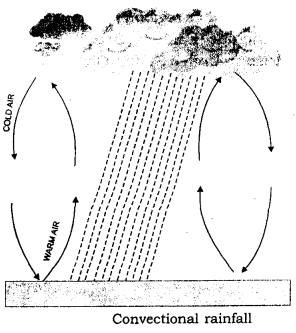
- Relief Rainfall : Relief rainfall is also known as Orographic Rainfall. It occurs from the cooling of warm moist air which ascends above the mountain barrier lying in the direction of the prevailing winds. The presence of mountains causes humid jair to rise. The sudden ascent causes cooling of air, leading to condensation and precipitation.
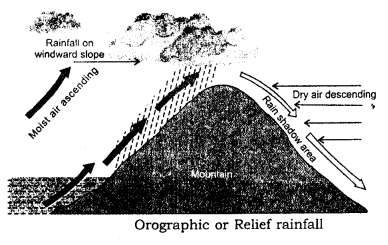
- Cyclonic Rainfall : This type of rainfall is due to cyclones and depressions. When warm and cold air masses confront each other, the warmer air generally climbs above the colder. The rising air is cooled while undergoing a frontal lift. This causes precipitation.
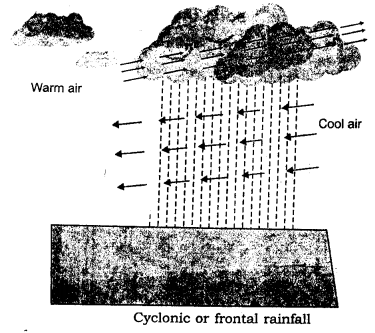
Question 4.
Define precipitation. Write short notes on three forms of precipitation.
Answer:
The process by which products of condensation, viz water droplets, ice crystals, sleet, etc., fall to ground is known as precipitation. Rainfall, snowfall, drizzle, sleet and hail are the chief forms of precipitation. Precipitation takes place only when they particles of water join together to form large sized particles which become too heavy to remain in suspension in the cloud.
- Rain : It is the most common form of precipitation. Raindrops of smaller size and less intensity are known as drizzle.
- Dew : When water vapour condenses on the surface, it forms tiny droplets of water called dew. Dew commonly occurs during winter on account of cooling of air below dew point.
- Frost : In very low temperature, when condensation occurs at zero metre or ground level, water vapour freezes into minute crystals of ice on objects near the ground such as blades of grass, leaves and tiny rock particles. Frost is harmful to plants.
Question 6.
Make a brief survey of the world distribution of rainfall.
Answer:
Equatorials and coastal areas of monsoon countries get maximum rainfall, more than 200 cm, sub-tropical areas get moderate rainfall 100-200 cm, and the least rainfall areas are Hot and cold deserts getting nearly 25 cm.
